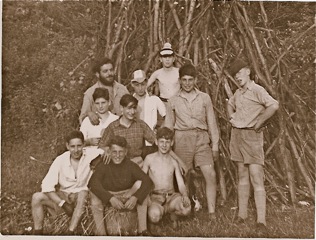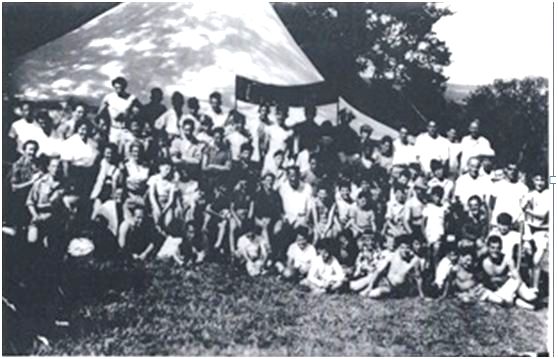JEWISH
EAST END OF LONDON PHOTO GALLERY & COMMENTARY
London's East End Synagogues, cemeteries and more......
My personal journey through the Jewish East End of London
e.mail thoughts & memories to:
Phil Twitter: @Philslondon
Jewish Walking tours with Phil - explore
your Jewish roots
If you would like me to
give you a guided walking tour of the Jewish East End of London or
perhaps of Jewish Soho in the West End of London, please email:
Phil Read more
about my tours
here
A PROVINCIAL YOUTH CLUB'S CONNECTIONS WITH
LONDON'S EAST END
By Michael
Swerdlow : Liverpool : April 2014
Phil,
You may
be interested to hear of the connections a Liverpudlian has with
your various stories about the East End of London.
Before WW2 my parents did their courting at Harold House Jewish
Youth Club in Liverpool. It was the Liverpool Jewish Community's
first purpose built social building, located close to the city
centre and where all the immigrant Jews lived similar to those in
London's East End.
It was primarily built as the HQ of
the Liverpool Battalion of the JLB but after the war became a youth
club for Jewish boys and girls.
My
parents encouraged me to join in 1955 when I was twelve. It was in
the same year that the club took as its youth leader a 25 year old
Londoner called Teddy Gold. Teddy was probably one of the country's
first trained and fully qualified Jewish youth workers from a
background at Jewish Youth movements in the East End of London and
came highly recommended by Sir Basil Henriques and Mick Goldstein of
the Association of Jewish Youth (AJY).

Teddy Gold with some of the Liverpool
boys, late 1950s
Teddy
introduced a wide, exciting and far reaching programme to all the
age groups of the club against a revolutionary structure of
self-help and involvement by its members. Parents got involved as
managers and helpers and the older club members became role models
befriending the youngsters like myself. We were encouraged to form
our own committees and take part in character building programmes.
Dozens of life long friendships were forged and Harold House
accounted for many marriages in the community.
With Teddy's London connections, he received regular invitations to
bring parties of club members to visit clubs like The Brady and The
Oxford and St George and the Bernhard Baron Settlement in Berner
Street, later Henriques Street.
For
some of us, the five hour journey by steam train to London was our
first experience of travel away from home without our parents.
It was exciting travelling on the
tube to Aldgate East and walking along Commercial Road where we were
put up over night at the settlement. We took part in activities and
our first experience of Petticoat Lane on the Sunday morning was an
eye opener.
The junior members always looked forward each year to joining the
London clubs at their under canvass camp at Highdown Hill near
Goring on Sea.

Goring by Sea petrol station
For several years the camp was run by a man they all
affectionately called Sos. I'm assuming that his resemblance to Jon
Sopel the BBCTV news reporter explains a connection. Another leader
was Sharkey Rosen who delighted us all with his repertoire from the
O.St.G songbook including, "We're the D Day Dodgers" and
"You can go anywhere for fourpence
on the Piccadilly Line."
These were our formative years and
the skills we learned and the fun and comradeship at these summer
camps was immeasurable. One year there was a violent thunderstorm
and a huge tree was blown down into the dining marquee. A
replacement was hastily ordered which was delivered the next day.
You can imagine the satisfaction on the faces of the Harold House
boys as the lorry drove up the hill bearing the name of the tent
supplier, J. Langdon Co of Liverpool.

Highdown Camp,
Goring by Sea, late 1950s
Friendships continued among the members of Harold House and the
various London Clubs which now included the Victoria Club in
Stamford Hill. I had just learned to drive and a gang of us didn't
give a second thought to jumping in the back of my Austin MiniVan
early in the morning as I drove to spend the day with our friends in
London, attend a party in the evening then drive back to Liverpool
in the early hours of the following morning.
Teddy encouraged me to sit on the northern members council of the
AJY which had strong ties with its counterpart in the south. In due
course I became its chairman and during my term of office I
organised a national AJY Conference which took place on Sunday 4th
April 1965 at Stepney Jewish Club & Settlement, Beaumont Grove,
London E1.
Vaguely following the title of the
popular television programme at that time, I called the conference
'Not so much a Conference, more a look at Youth,' which was very
well attended. We listened to speakers including Reverend Robert
Skillern the religious advisor to the National Association of Boys
Clubs and Ray Gosling, the controversial youth leader and
journalist, talking about his recent book on the youth service,
"Lady Albermarle's Boys.' My conference co-chairman was Roger Siskin
and other speakers included colleague Barry Epstein.
I notice in the write up about Basil
Henriques in the London's Jewish East End website, it mentions that
each night at the end of club sessions, members would come together
to share thoughts and a prayer in the form of the last two lines of
Adon Olom - (Into your hands we entrust our spirits etc etc). Teddy
Gold conducted this very ritual when he was the leader of Harold
House and we all thought it was a marvellous part of club life. For
many years in my youth I never realised where Teddy got these lines
from until I eventually saw it in the siddur translation. And now,
reading about Henriques, I can see where Teddy got it from.
I am one of hundreds of old Harold
House members who owe a lot to Teddy, and it is clear to see that in
turn we owe a lot to Sir Basil Henriques.

Portrait of Sir Basil Henriques in
his office in Berner Street
All of
which certainly motivated me to give something back to my own
community. I eventually served for four years as the Chairman of
Harold House Youth Club followed by a six year term as Chairman of
the Liverpool Jewish Youth and Community Centre which incorporated
Harold House. My own children have grown up through Harold House and
to this day I continue to serve our community in one way or another.
Sadly
the Liverpool Jewish Community has shrunk from around 12,000 when
Harold House was first built to around 2000 today and, along with
one or two other communal organisations, our community centre and
Harold House has had to close down. The community neither needs nor
can afford the upkeep of large buildings, but its salvation came a
few years ago when our Jewish School King David was selected by the
government to be part of a new build scheme. The architects included
a suite of rooms in the new school to be used by the community and
they now share the school's facilites. But gone are the days of
hundreds of Jewish children busily taking part in activities in
every corner of a thriving building. Gone are the philanthropists
and gone are the days of dozens of committees and teams of
volunteers organising and fund raising for every known aspect of the
community's activities. It's a different world.
In my
retirement I put my hobby to work and produced a documentary video
called 'Chicken Soup and Scouse' which charts the history and
contribution of the Liverpool Jewish Community from the 1700s to the
present day. I am now working on a new documentary on the
fascinating history of Harold House going back to the early 1900s.
Written by
Michael Swerdlow, 213 The Colonnades, Albert Dock, Liverpool L3 4AB
Email : [email protected]